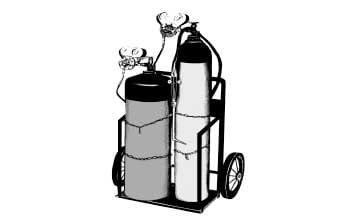Working Safely When Welding
Here are some key points.
- Welding can be very hazardous.
- Only weld in authorized areas with adequate ventilation and fire protection.
- Always wear the appropriate clothing and personal protective equipment.
Welding can be very dangerous
- Welding and cutting are jobs that enable us to get our work done.
- But these tasks also present many hazards. Among them are:
- fire hazards
- electrical hazards, including the possibility of a fatal electrical shock
- exposure to toxic fumes and gases
- loud noise
- burns to the skin
- eye injuries, resulting from burns or from particles that get into your eyes
- It’s important to always think about safety when you are welding or cutting. Failure to do so could result in serious injury – or even death.

Serious eye injuries can result from welding.

Always wear the proper protective clothing for welding.

Always support pressurized cylinders so they don’t tip over.
Before you begin
- Carefully review the operator’s manual of the equipment you will be using. Also, be sure you are authorized to use the equipment and have been specifically trained in its use.
- Make sure the area is well ventilated to prevent the accumulation of toxic fumes or gases. Never use oxygen for ventilation. Instead, open doors or windows and use exhaust fans, or other means.
- Check for potential fire hazards. Make sure there are no combustible materials nearby. If there are, move them at least 35 feet away from the welding and cutting area. Also, be sure water, sand, and a working ABC fire extinguisher are nearby. See your supervisor if you have questions.
- Never weld directly on a wooden floor. Wet down or protect any flooring that could burn. Also, protect any wooden beams, partitions or scaffolds that could catch on fire.
- Consider erecting a curtain to keep passersby from viewing arcs.
- Never direct a torch toward another person while it is being lighted.
Dress appropriately
- Wear pants without cuffs; avoid clothes and gloves with snags, tears or worn spots; keep all pockets empty and sealed; and never wear clothing made of synthetic materials such as polyester or nylon, which could melt onto your skin. Leather or wool are better choices than cotton or flannel, unless the material has been treated to resist fire.
- Depending on the specific job, we may also require you to wear:
- a welding helmet
- a fire-resistant shirt, coveralls, apron, pants and/or chaps
- fire-resistant gloves
- high-top leather or rubber boots
- a respirator
- goggles
- hearing protection
More important safety tips
- Carefully check your pockets for lighters or anything else that could be dangerous around heat or flames.
- Never weld, cut or do related work on drums, barrels or tanks. They could explode.
- Pay close attention to the floor surface. Steel, for example, conducts electricity. In such cases, you’ll need an insulating mat.You’ll also need a rubber mat to stand on if the ground is wet.
- Support pressurized cylinders so they can’t tip over. Make sure cylinder caps are screwed on tight.
- If a cylinder leaks around a valve or fuse plug, tag it to indicate the fault, and immediately notify your supervisor.
- Know that we may require a second person to stand by with a fire extinguisher to put out any fires resulting from sparks.
- Don’t weld near rooms where flammables are stored.
- Keep all welding equipment free of oil and grease.
Welding Safety Do’s and Don’ts
Do
- Only weld in authorized areas. Make sure the area is dry, free of chemicals and adequately ventilated.
- Inspect the equipment you will be using before you start.
- Keep people away unless they are authorized to be there and are wearing the appropriate personal protective equipment.
- Use equipment that’s defective or not in good repair.
- Weld with upturned sleeves or collars because sparks could get caught in them.
- Lay down a torch on a table with oil residues. Oil and oxygen do not mix.
When you’re ready to work safely, you’re ready to work. See our full line of safety supplies, including respirators, eye and ear protection, coveralls, first aid and more.







